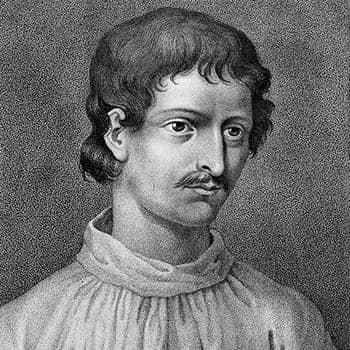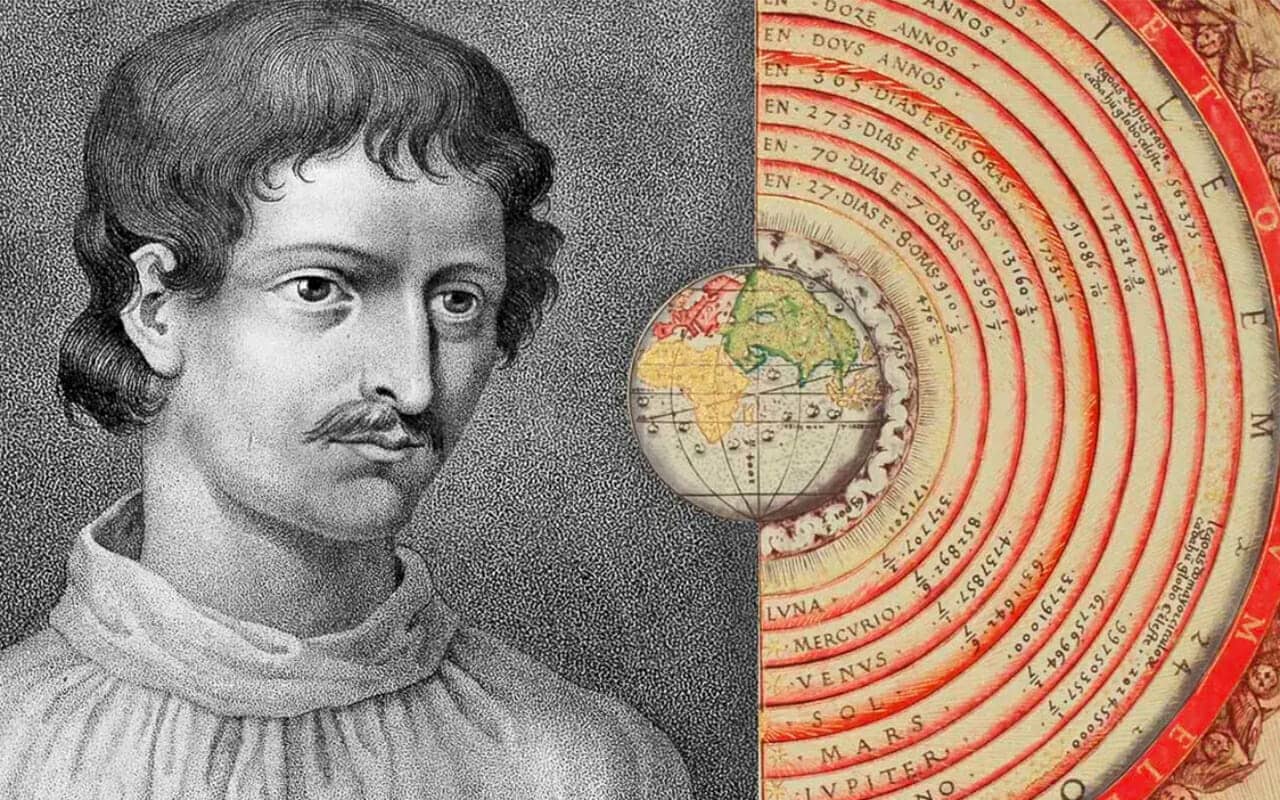Podcast: Download
Subscribe: Apple Podcasts | RSS
 Giordano Bruno wrote many books about memory techniques.
Giordano Bruno wrote many books about memory techniques.
The mnemonic strategies they contain are really good.
But many are notoriously difficult to read.
For one thing, Bruno rarely just gets down to teaching the techniques. They’re often mixed in with all kinds of elaborate astronomy and philosophy.
Was there any method to this madness?
Or was he just a hack?
You’re about to discover the answer to these questions on this page.
And the truth about Giordano Bruno’s approach to using memory techniques for learning will surprise you.
Ready?
Let’s dive in!
Who Was Giordano Bruno?
The biography of Giordano Bruno can be difficult to wade through.
His fans adore him for a variety of reasons. They might admire his early understanding of memory science. Or they admire his contributions to early astronomy. Some people even see him as a symbol for freedom of expression and thought.
Others criticize him, especially for refusing to recant when the church accused him of heresy.
Either way, we believe Giordano Bruno was born in 1548 in Nola, a town in southern Italy. He became a Dominican priest in 1572 and earned a doctorate in theology in 1575.
That same year, the authorities investigated him for holding controversial views on the Trinity. Later, in 1600, the Inquisition burned Bruno at the stake for refusing to recant on his views. According to Ingrid Rowland in her study of his life, Bruno denied that Christ was a person. In fact, he denied that anyone was a person, an argument so nuanced, his trial was put on hold for two weeks as the authorities discussed its ins and outs.
Although you could argue that Bruno was merely being stubborn and provocative, current neuroscience, psychology and experts belonging to related fields have confirmed what is now called the Nonself hypothesis.
Bruno’s Philosophy At A Glance
Bruno’s ideas can be hard to follow because he was a polymathic learner. He referred to the words of Plato and Aristotle along with references to Ramon Llull and many other thinkers. His ability to remember the granular details of such a wide variety probably frustrated him, especially when others couldn’t keep up.
What were his ideas and why did he hold them to be philosophically important?
To pick a starting point, it concerned Bruno that many people focused on Aristotle’s materialism at the expense of the metaphysical ideas of St. Thomas Aquinas. He worried that concentrating on just one form of logic would reduce critical thinking, rather than increase it.
As a result, people remained fixated on an incorrect model of the universe. Bruno’s alternative theory focused on the universe as infinite and indivisible. He believed in one Universal Soul that collaborates with Universal matter to create reality based on an ongoing process of regeneration and decay.
Bruno extended these ideas to his definition of God. And like St. Augustine, extended them to reflect on the nature of memory. Unlike Augustine, however, Bruno found time to teach mnemonic strategies that people still use today.
The Basic Memory Techniques Of Giordano Bruno
Bruno’s memory techniques are not particularly original to him. However, his manner of teaching mnemonics is unique. There is no one quite like him, not even Robert Fludd, who shared similar philosophical ideas.
Bruno’s uniqueness comes through in a few ways. He often taught techniques like the Memory Palace through his commentaries on other teachers. In his Opere lulliane, for example, he gives a far clearer description of how to create a well-formed Memory Palace than in any of his own books that I’ve read:
In the basic system of the classical Art of Memory, also known as the method of loci or Memory Palaces, you must follow a basic set of rules. To remember anything, convert them into images and then distribute those images in a set of places around a building or other structure in a sequenced order.
To retrieve those images, retrace your steps through the sequences of places, viewing and decoding each of the images as you go. The places should be well lit, not too far apart and not crowded together and distinctive from one another. The whole structure should be clearly visualized. The path you take should be obvious, so you will not get lost, and to facilitate retrieval.
There is also advice on how to make the images themselves as memorable as possible. They should be visually striking and emotionally resonant. (They may be terrifying, inspiring, or humorous.) They should be visualized as clearly as possible. The images should not blend into the background of the places. If a thing that is to be remembered, is not easily visualized, then you may choose to encode letters or syllables of the name of the thing into a set of predetermined images.
Bruno copied most of this very clear teaching from Rhetorica ad Herennium. People repeated this basic description of the journey method so often, Frances Yates calls this exact description the “Herennium Pattern” in her book, The Art of Memory.
Bruno’s Advanced Mnemonics
Fortunately, Bruno went much deeper. In fact, some of his ideas about how Memory Palaces can potentially be infinite are so complex, they’re best explained via the magic of video:
For the rest of this article, let’s learn some of his more practical approaches for crafting mnemonics that will help you learn faster. In his wonderful book, On the Composition of Images, Bruno covers multiple aspects of visualization. I have yet to encounter such a wide variety of mnemonic images in any other Memory Palace book.
To give you a taste of his wonderful encoding tools, here are some of my favorite:
Sound Association
Technically, any direct association is a sound association (horse sounds like horse). However, you can also use sounds to “trigger” the target information you want to encode and later recall. For example, equus, the Latin word for “horse,” could be used to memorize the word “equality.”
Word Division
When you need to memorize words, break them up or “divide” them in the most useful ways possible. For example, if you need to memorize the word contemplation, consider using the image of a bank robber for “con” and have him robbing a temple in your Memory Palace for the second part of the word.
Meaning Association
When you know what certain words mean based on roots like Latin or Greek, this knowledge can be leveraged for making powerful associations.
For example, Philip is a relatively popular name that means “lover of horses.” Anthony supposedly meant “leader.” If you meet someone named Anthony, you can imagine yourself or someone else as a leader pointing to the person.
Relational Associations
White can make you think of snow, or vice versa.
Honey = sweet
Lions = ferocity
Turtles = patient and persistent
Now, you might be thinking: That’s all find and dandy. But can you apply this kind of mnemonic strategy to memorizing medical terminology?
Absolutely. If you have to memorize the names of insulin medications, for example, insulin glargine is long acting. You can relate the act of glaring for a long time to drinking gin for even longer. Using sound association, you can include actors like Justin Long and Gina Davis.
Often, using relational associations cannot be done in isolation. But adding them to supplement your other mnemonic associations often adds the extra layer of memorability you need.
Conceptual Associations
There are a few ways to understand this form of association. For example, you can use genres. Science Fiction is a Conceptual Mode of storytelling.
Or you can leverage concepts like Mars being the god of war. This is a concept that differs from Mars as a planet or a chocolate bar. It is a conceptual metaphor that has been used throughout history to make all kinds of information memorable.
Now, you might be asking… “How is this different from the sword of justice as a visual metaphor?”
This is a good question. Although you might see a sword in the hand of Mars, the god of war, you don’t have to visualize anything to get the concept. The key to mastering this kind of association is to give yourself the benefit of experience. You’ll soon develop a sense for which kinds of conceptualizatoins are most useful for you.
Congruent Actions
Let’s end this list in a similar spot to where we began. If a direct association would be using a horse to help you remember a horse, in this case we’re using an action to remember an action.
Examples:
- A thief does some thieving
- A doctor does some doctoring
- A preacher does some preaching
The opposite of congruent actions is naturally incongruent actions.

Beyond Bruno
Bruno offers many more types of association, so I encourage you to read his writing yourself. Scott Gosnell has provided several serviceable translations, and shared many wonderful insights about the Renaissance memory master.
In addition to Gosnell’s Bruno series, John Michael Greer recently produced perhaps the best translation of On the Shadows of the Ideas I’ve yet seen in English.
The point Bruno returns to repeatedly is that you need to take action with the techniques. You need to experiment as you explore them. And his stubbornness often comes through in a way that can definitely confuse a lot of readers. For example, he equates not taking action with death in On the Shadows of the Ideas.
Obviously, people do not drop dead if they don’t use memory techniques. I believe that Bruno is being more than a little Zen. He’s trying to wake his readers up so that they pay attention to the details. As Martin Faulks has shown in his demonstrations of Bruno’s techniques, the details do really matter.
So if you’d like to know more about how to use Memory Palaces properly with a special focus on having the most effective associations possible, feel free to register for my free course:
I’ve been a student of Bruno’s for decades and a lot of what you’ll learn is based on a modernization of his most powerful descriptions of the best ancient memory techniques he knew.
Bruno isn’t for everyone, that’s for sure. But I’ve done my best to explain some of his best ideas so that you can put them to use in your personal practice. If you find him too challenging at the present moment, perhaps select a book like Unlimited Memory first and then come back to him later.
Either way, I follow Bruno’s message by suggesting that you focus on mastering the fundamentals no matter from whom you learn these techniques. That way, you’ll be able to learn faster and remember more.
The trick will be to live in such a way that you stay out of hot water. Bruno was convinced of a particular interpretation of truth and he valued it more highly than his own life.
And no doubt. He didn’t believe in our concept of personhood, after all. Perhaps that was what allowed him to explore memory at a deeper level. His critics insist that his ego led him to a premature end.
But from a memory perspective looked at through the lens of contemporary psychology, perhaps Bruno was able to memorize so much because he knew that his ego was not real. He didn’t let his worries and concerns get in the way of taking action. Perhaps he was also enlightened in the same sense many Sanskrit phrases discuss: he experienced himself as part of a larger process that in no way relied on his individual identity.
As he told those who condemned him to death:
Perhaps your fear in passing judgment on me is greater than mine in receiving it.
These words have always struck me as proof that Bruno had managed to see through the illusion of being a separate person.
One way or another, Bruno made a huge impact. People still consider not just one set of his ideas, but several. That’s more than enough evidence to show that whatever he was doing in his mind and memory has so far stood the test of time.
Related Posts
- John Michael Greer On Giordano Bruno, Memory and Time
Listen as John Michael Greer discusses his translation of Giordano Bruno's On the Shadows of…
- Memory Improvement Techniques For Kids
You're never too young to get started with memory techniques







